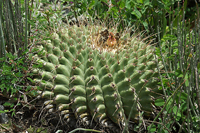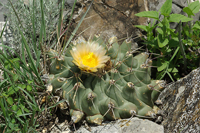Holotype: Road from Cienega del Toro to Santa Rosa on a gypsum hill, Municipio Galeana, Nuevo León, Mexico, 1610 m, 3 October 1995, Hinton et al. 25778 (Herbarium G.B. Hinton).
The collection number given in the protologue (25762) is wrong, referring to a fern. Type citation was amended in Cactaceae Systematics Initiatives 26: 19 (2012).
Synonyms: Thelocactus lophothele ssp. hintonii Matusz., Thelocactus 177 (2011).
Description
Stem single, depressed or globose, up to 20 cm wide. Ribs 24, distinct. Tubercles conical. Areoles without glands. Central spines 3-4, 50 mm long, ochre to greyish, slightly curved, acicular. Radial spines 0-6, 15 mm long, ochre to greyish, slightly curved, acicular. Flowers 45 mm wide, yellow to pinkish. Seeds 1.9 x 1.5 mm, testa cells tabular or slightly convex with a verrucose surface sculpture.
Distribution
Mexico, Nuevo León, known only from a small area west of Rayones, occurring in matorral xerofilo on limestone hills, at elevations of about 1600 to 1700 metres above sea level. Its range lies within the Meseta Central subregion of the Chihuahuan Desert ecoregion.
Thelocactus rinconensis ssp. hintonii Luethy, Kakt. and. Sukk. 48: 39 (1997).
 The type of Thelocactus rinconensis ssp. hintonii Luethy
The type of Thelocactus rinconensis ssp. hintonii Luethy
Road from Cienega del Toro to Santa Rosa, Nuevo León 3 October 1995, Hinton et al. 25778 (GBH).
Image courtesy CONABIO.
enlarge
 Thelocactus rinconensis ssp. hintonii
Thelocactus rinconensis ssp. hintonii
Santa Rosa, Nuevo León
Photo: J. Jauernig
enlarge
 Thelocactus rinconensis ssp. hintonii
Thelocactus rinconensis ssp. hintonii
Santa Rosa, Nuevo León
Photo: J. Jauernig
enlarge
 Thelocactus rinconensis ssp. hintonii
Thelocactus rinconensis ssp. hintonii
Santa Rosa, Nuevo León
Photo: J. Jauernig
enlarge